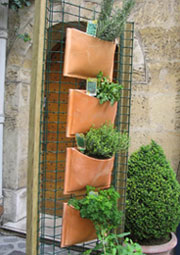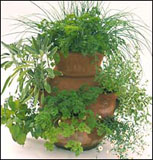Growing herbs indoors this winter


Replant the Outside, Inside
Another way to start a winter herb garden indoors is to move plants from your garden into your kitchen.
You won’t want to uproot whole plants, because by this time of year they are far too large for just about any windowsill. Buying pots for huge herbs would cancel out any savings you might make by growing gargantuan greens indoors. What you want to save are pieces of the plant runners or divisions. Herbs like chives and mint divide easily; others require a bit more work.
However, since the plants at this point are basically freebies, you don’t need to concern yourself as much with what will make it through the dry-heat season indoors. If they die, they die, and you’ve had free fresh herbs out of season for however long it took those ill-fated herbs to sputter out.
 Do not consider any such windowsill sputtering as a gardening failure. Consider it scientific experimentation and financial pioneering. Maybe you do want to try growing that basil indoors after all.
Do not consider any such windowsill sputtering as a gardening failure. Consider it scientific experimentation and financial pioneering. Maybe you do want to try growing that basil indoors after all.
Instructions:
1. To transfer suitably-sized outdoor herbs to your windowsill pot, look for new growth. Some herbs can be divided. Others, such as this golden thyme, can be separated from the mother plant by inserting a trowel sharply just behind the newly-formed roots of an advancing stem.
2. Put the plant and root ball in a plastic bag to transport it back to your kitchen sink or potting table.
3. Pot it up, water thoroughly, and sharpen your scissors.
 Care Tips:
Care Tips:
- Because most herbs are fairly drought resistant, they grow well in pots, but when you combine two or three in the same container, they must be compatible in their moisture requirements.
- In heated homes during winter, mist around plants frequently to circumvent the dry air, this will inevitably lead to brown leaf tips and spider mites. (Rosemary is particularly susceptible to the latter).
- Fertilize herbs once a month or incorporate a slow release plant food in the soil before planting. Herbs produce the best flavour if you do not overfeed them.
- Give plants a quarter-turn weekly to expose all sides to the sun.When your herbs receive the right amount of water they will flourish and thrive. While it is important to make sure your herbs are getting enough water, overwatering can also be harmful to your garden. Keeping an eye on the moisture level of your soil will give you a good idea of how often you need to water your herbs.Typically, once every one to two weeks will be plenty. Water just enough to keep the soil moist. Too much water can deprive your plant of oxygen. Yellowing of the leaves is a sign of over watering!
Raising your own herbs is a wonderfully satisfying occupation.
•With thanks to Elaine Jarvis
Share to: Facebook Twitter LinkedIn Email
More in food, garden, heating, work
By FrenchEntrée
Leave a reply
Your email address will not be published. Required fields are marked *



